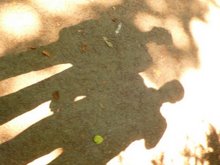This lesson asks students to observe, react and create symmetrical designs found in their immediate and distant environment and culture.
Students Will
Identify four basic forms of symmetry
Recognize symmetry in everyday objects and life forms
Recognize symmetrical patterns in cultural art
Create symmetrical designs
Standards:
Mathematical Reasoning - Students use mathematical reasoning to analyze mathematical situations, make conjectures, gather evidence, and construct an argument.
Modeling - Students use mathematical modeling/multiple representation to provide a means of presenting, interpreting, communicating, and connecting mathematical information and relationships.
Patterns - Students use patterns and functions to develop mathematical power, appreciate the true beauty of mathematics, and construct generalizations that describe patterns simply and efficiently
_______________________________________
WEEK ONE- WHAT IS SYMMETRY
INTRODUCTION – The Mathematics of Symmetry
A WHOLE CLASSROOM ACTIVITY
The student cuts out shapes of pattern blocks from a sheet of paper. Folding each in half leads to the discovery that both halves are identical in shape and size. From this observation comes a discussion that leads to a definition for the line of symmetry and the symmetrical form of reflection.
Introduce the students to the four basic forms of symmetry: translation, reflection, rotation and glide.
Visual examples galore by using multiple kinds of media. Heavy exposure to symmetry.
The following site supports as a whole class presentation; examples of each symmetrical form http://forum.swarthmore.edu/geometry/rugs/symmetry/basic.html
Students go through the alphabet to identify letters that have a line of symmetry.
<><><><><><><><><><><><><><><>
REFERENCE
http://forum.swarthmore.edu/geometry/rugs/resources/glossary.html
..............................................................
WEEK TWO - IT'S ALL AROUND US
This week's activities will move the students from the math of symmetry to its application.
OBSERVING SYMMETRY –
For Example: symmetrical shapes and patterns found in nature, patterns on walls and floor coverings, fabrics, and jewelry.
Look through print media for examples of symmetry and identify
GOING ON-LINE
View examples of symmetry in commercial and cultural design and nature.
FOLK ART
http://www.folkart.com/~latitude/hex/hexx.htm
Students can use this site to learn how these people combined symmetry and form to design this folk art.
Abstract Ideas: Interpret the meaning of the colors, shapes and images.
ACTIVITY – RUG SYMMETRY
All around the world floor coverings have the art of symmetrical patterning.
The Navajo People
Students will read a bit about the history of rugs:
http://www.indiantraders.com/aboutart/textiles/navrug1.htm.
To view several examples of Navajo rugs
http://www.americantrails.com/at_rugs.html.
Create a design with geometric shape blocks!
ACTIVITY – SYMMETRY IN NATURE
Many living things have symmetry in their shape and some have color symmetry as well.
Show class the butterfly site, http://butterflywebsite.com/gallery/index.cfm to observe the symmetry of color and shape of butterfly wings.
ASSIGNMENT
The student will look for different images each of animal and plant life for symmetrical shape and/or color. Documenting over time and sharing with the class.

No comments:
Post a Comment